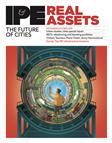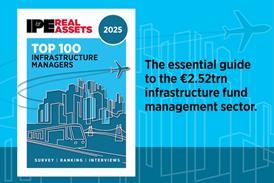The case for global property diversification is strong but to achieve this investors must choose their markets carefully, says Paul Mitchell
A key feature of institutional portfolios over the last 30 years has been an on-going rebalancing of equity exposures towards international markets. In the UK, for example, the domestic/international split is now roughly 50:50 - something which, given UK equities' much lower share of the global market, still implies a significant ‘home bias'.
For property, institutional portfolios until recently have been overwhelmingly domestic. However, investors are increasingly recognising that cross-border property investment iss an untapped and decent-returning source of diversification for their multi-asset portfolios.
Tapping into markets which offer better returns than bonds, and which are lowly correlated with their existing exposures, is becoming increasingly important to institutional investors. This has been coupled with a substantial improvement in accessibility to international property markets through funds, as well as directly over the last few years.
Even so, with only a proportion of investors considering cross-border property investment and those that are doing so (in the UK) limiting allocations to 10-20% of their overall property portfolio, home bias among property portfolios is still very substantial. For example, in the UK something like 7.5 times more money is allocated to domestic property than its global share of property would justify, compared with only 4.5 times more for UK equities.
The strategic case for cross-border property investment is extremely strong and has been widely reported: in a nutshell, low correlations between countries imply lower risk for a portfolio which includes cross-border property. Figure 1 illustrates the reductions in risk experienced by UK, French and Swedish investors over the last 15 years by adding cross-border exposures to their domestic property portfolio. For example, by shifting from a purely domestic portfolio to a fully diversified portfolio in the world's major property markets, a French investor would have seen their portfolio's risk fall from 7.5% to less than 4%.
The calculations assume the investor has an index exposure to the market. However, even at this basic level, care must be taken to ensure such benefits are realised. For example, because it has been relatively highly correlated with countries, adding US property to a domestic portfolio would have been relatively inefficient in most European countries.
Adding cross-border markets to a German property portfolio would have increased risk (albeit with much enhanced returns). The reason is that the German property market over the last 15 years - even after taking into account conservative German valuation practices - has seen lower levels of risk than the rest of the world.
A major reason cited for not pursuing a global strategy is that property's heterogeneity means that the apparent diversification benefits illustrated in figure 1 may not be realised; unless substantial amounts are cross-border investment, an investor may be exposed to high levels of specific risk. Furthermore, it may be better to concentrate resources on improving diversification in the domestic portfolio.
This article reviews such concerns, drawing on recent work by Henderson Global Investors' property research team, and in particular on its extensive database of national property market returns and local market performance dating from the early 1990s.
The approach taken is to simulate the effect of adding ‘assets' to a portfolio rather than the unobtainable exposures portrayed in the national indices. Synthetic historical returns are generated for almost 400 prime locations in the UK, continental Europe and Asia. Whereas the data refer to a refined set of prime assets in prime locations and abstracts from the effects of lease structures, their characteristics in aggregate broadly correspond with the national indices, thereby indicating the approach is likely to be reasonably representative.
Figure 2 illustrates the impact of adding such assets to portfolios. In the UK, diversification benefits accrue very slowly after the first few assets, with a portfolio on average being 75% diversified with 50 assets, 90% diversified with 100 assets, and virtually fully diversified with 200. These estimates are broadly comparable with the more robust analysis, published by the Investment Property Forum, based on the analysis of actual assets.
In continental Europe, the diversification benefits from adding assets accrue more quickly. Furthermore, a widely diversified portfolio on the continent has been less risky than a UK portfolio. This latter observation is consistent with the results of analyses based on IPD portfolio returns - something which has been treated with scepticism in the face of concerns over valuation practices on the continent. It is reassuring therefore that analyses using market evidence support the observation that continental European property generally is less risky than UK property.
More fundamentally, figure 2 highlights the positive impact of having a combined UK and continental European portfolio - other than for small numbers of assets, a pan-European portfolio brings diversification benefits to both UK and continental European property investors.
To emphasise the benefits of a cross-border strategy, figure 3 addresses the question: ‘What is best for a UK investor's portfolio risk - adding assets to a UK property portfolio or going cross-border?' In particular, it considers the trade-off for a UK investor with 25 domestic properties.
There is little diversifying benefit from adding extra UK assets to a domestic portfolio of 25 properties. Adding continental European assets is much more efficient, generating significant diversifying benefits at first and being more helpful than adding UK assets. This is because continental European assets are less correlated with UK assets than UK assets are with each other and because a UK domestic portfolio is well on the way to be being diversified with 25 assets. Only if specific continental assets are typically much more risky than UK assets would this finding be undermined.
The analysis so far relates to the average across 100 random portfolios, around which there is considerable variation, as illustrated in figure 4. Such variation exists even with large numbers of assets. There is the possibility therefore that portfolio risk may not be reduced and that the expected diversification benefits may not be achieved.
Such a possibility can be guarded against through judicious selection of assets or through a fund of funds approach, which combines separate portfolios, like those offered by a variety of fund managers. This is a relatively recent addition to the market offer and has a marked positive impact on enabling cross-border investment.
Alternatively, some investors try to ensure the diversification benefits of cross-border investment by using a more specialised approach. Figure 5 shows how the characteristics of continental European assets vary. The retail and industrial sectors are clearly the least risky.
Within the office sector there is a marked contrast between the major continental centres such as Frankfurt, Amsterdam and Paris - which show comparatively high levels of volatility and correlations with each other - and the smaller markets (eg, Lyon, Stuttgart) where risk and cross-correlations are lower and whose characteristics are comparable to retail and offices.
Furthermore, the major continental office centres have also been relatively highly correlated with central London, suggesting that UK investors seeking to diversify on the continent would be best placed by turning their attentions beyond the major continental cities. (The same will apply to continental investors going into the UK.)
For example, UK investors might be better served by investing in a specialist sector fund rather than a ‘balanced' portfolio closely related to the IPD Index which invariably would be dominated by big city offices. A similar strategy could be followed when pursuing a fund of funds approach.
While Asian property markets tend to have low correlations with the UK and continental Europe, they are also characterised by high volatility and risk. Because the dominant Japanese office market has performed poorly, it is questionable if the returns in Asia as a whole have been sufficient to compensate for this.
Over the longer term, performance does look to have been more commensurate with the risk. The suggestion is that, compared with other types of cross-border property investment, a strategy of investing in Asia will be more about return enhancement than risk reduction.
Even so, the low correlations with western property markets suggest that diversifying into Asia property markets is likely to reduce portfolio risk. However, our simulations indicate that a major impediment would be an exposure to the Tokyo office market commensurate with its large weighting in the Asia region. If past levels of volatility are repeated, such a strategy would undermine the diversification potential from cross-border property investment into Asia.
Hence, a wide-spread exposure across Asia, rather than one concentrated in the dominant but volatile Japanese market, would have been the most appropriate approach.
Until relatively recently, access to international markets has been extremely difficult. Diversified exposure required substantial direct investment only available to the largest investors. Over the last eight years there has been a rapidly accelerating development of funds investing in a range of country/sector or diversified assets. This has been enhanced in the last two to three years by the introduction of funds of funds to the private market, mostly for institutional investors, together with further developments in listed vehicles.
The development of fund of funds vehicles has been especially important, given the myriad of tax regulations, fund structures and variations to market practices, which are generally quite beyond the capacity of the smaller institutional investors to assimilate. Through fund of funds, therefore, the smaller as well as large investor is able to get diversified exposure.
In conclusion, the case for a cross-border property investment strategy looks compelling, not only in theory but in practice. Such a strategy, however, needs to be implemented carefully to ensure that the diversification benefits are achieved. Simply seeking a balanced exposure in line with local structures, in the same way that investors follow in their domestic markets, may not maximise the diversification benefits of cross-border property investment.
At the same time, the comparatively small amounts invested imply some uncertainty over the level of specific risk in a cross-border portfolio and the corresponding diversification gain.
Both fund of funds and specialist sector approaches represent ways by which investors could circumvent these impediments and thereby maximise the diversification benefits of cross-border investment.
For fund managers, a cross-border capability is now the sine qua non. At the same time, it is becoming increasingly important that fund managers have the capability to cater for a range of strategies - balanced, specialist, funds of funds, etc.
This article was written in conjunction with Simon Bryant, head of economics and property forecasting at Henderson Global Investors






